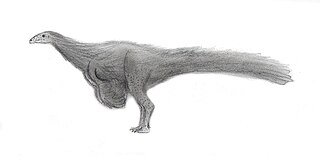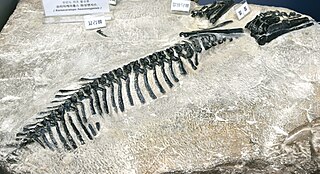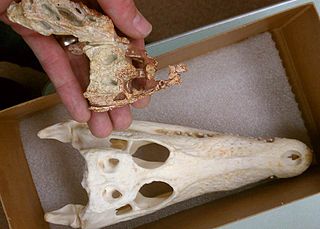
Crichtonsaurus is a dubious genus of herbivorous ankylosaurid dinosaur that lived during the Late Cretaceous in what is now China. It was named after Michael Crichton, the author of the famed dinosaur novel Jurassic Park.
Chiayusaurus is a genus of sauropod dinosaur known from teeth found in China and possibly also South Korea. Two species have been named for this obscure genus, though only the type, C. lacustris, is still seen as valid. It was originally named as Chiayüsaurus, but the ICZN does not permit special characters, so the name was corrected to Chiayusaurus. The obsolete name can still be seen in older sources, though. As a sauropod, Chiayusaurus would have been a large, quadrupedal herbivore.
Protohadros is a genus of hadrosauroid dinosaur from the Late Cretaceous, 95 million years ago.

Nqwebasaurus is a basal coelurosaur and is the basal-most member of the coelurosaurian clade Ornithomimosauria from the Early Cretaceous of South Africa. The name Nqwebasaurus is derived from the Xhosa word "Nqweba" which is the local name for the Kirkwood district, and "thwazi" is ancient Xhosa for "fast runner". Currently it is the only named coelurosaur discovered in Africa and shows that basal coelurosaurian dinosaurs inhabited Gondwana 50 million years earlier than previously thought. The type specimen of Nqwebasaurus was discovered by William J. de Klerk who is affiliated with the Albany Museum in Grahamstown. It is the only fossil of its species found to date and was found in the Kirkwood Formation of the Uitenhage Group. Nqwebasaurus has the unofficial nickname "Kirky", due to being found in the Kirkwood.

Ichthyornithes is an extinct group of toothed avialans very closely related to the common ancestor of all modern birds. They are known from fossil remains found throughout the late Cretaceous period of North America, though only one species, Ichthyornis dispar, is represented by complete enough fossils to have been named. Ichthyornitheans became extinct at the Cretaceous–Paleogene boundary, along with enantiornitheans, all other non-avian dinosaurs, and many other animal and plant groups.

Terminonaris is a genus of extinct pholidosaurid crocodyliforms that lived during the Late Cretaceous epoch. The name means: “enlarged snout or nose” at the front of the skull. Terminonaris is an early crocodile, within a subgroup called Mesoeucrocodylia. Its remains have only been found in North America and Europe. Originally known under the generic name Teleorhinus, it was once believed to be a teleosaurid. Both prehistoric crocodiles such as Terminonaris, as well as modern crocodiles, belong to the same group called crocodyliformes, although modern crocodiles have specific features that indicate they are distant relatives of this species and members of the subgroup Eusuchia.

The Woodbine Group is a geological formation in east Texas whose strata date back to the Early to Middle Cenomanian age of the Late Cretaceous. It is the producing formation of the giant East Texas Oil Field from which over 5.42 billion barrels of oil have been produced. The Woodbine overlies the Maness Shale, Buda Limestone, or older rocks, and underlies the Eagle Ford Group or Austin Chalk. In outcrop the Woodbine Group has been subdivided into the Lewisville Sandstone, Dexter Sandstone, and/or Pepper Shale formations. Thin-bedded sands of the Woodbine and Eagle Ford are collectively referred to as the "Eaglebine" oil and gas play in the southwestern portion of the East Texas region.

Beishanlong is a genus of giant ornithomimosaurian theropod dinosaur from the Early Cretaceous of China.

Uktenadactylus is a genus of anhanguerid pterodactyloid pterosaurs from the Lower Cretaceous Paw Paw Formation of Texas, United States and the Wessex Formation on the Isle of Wight, England. Fossil remains of Uktenadactylus dated back to the Early Cretaceous period, from about 125 to 100 million years ago.
Flexomornis is a genus of enantiornithean birds known from fossils found in Texas rocks belonging to the Woodbine Formation dating to the middle Cenomanian age of the late Cretaceous period. It contains a single species, Flexomornis howei, named for the amateur fossil hunter Kris Howe, who discovered the site where the fossils were found.
Aetodactylus is a genus of targaryendraconian pterosaur. It is known from a lower jaw discovered in Upper Cretaceous rocks of northeastern Texas, United States.

During most of the Late Cretaceous the eastern half of North America formed Appalachia, an island land mass separated from Laramidia to the west by the Western Interior Seaway. This seaway had split North America into two massive landmasses due to a multitude of factors such as tectonism and sea-level fluctuations for nearly 40 million years. The seaway eventually expanded, divided across the Dakotas, and by the end of the Cretaceous, it retreated towards the Gulf of Mexico and the Hudson Bay. This left the island masses joined in the continent of North America as the Rocky Mountains rose. From the Cenomanian to the end of the Campanian ages of the Late Cretaceous, Appalachia was separated from the rest of North America. As the Western Interior Seaway retreated in the Maastrichtian, Laramidia and Appalachia eventually connected. Because of this, its fauna was isolated, and developed very differently from the tyrannosaur, ceratopsian, hadrosaurid, pachycephalosaur and ankylosaurid dominated fauna of the western part of North America, known as "Laramidia".

Koreaceratops is a genus of basal ceratopsian dinosaur discovered in Albian-age Lower Cretaceous rocks of South Korea. It is based on KIGAM VP 200801, an articulated series of 36 caudal vertebrae associated with partial hind limbs and ischia. This specimen was found in a sandstone block that had been incorporated into the Tando dam at Hwaseong City; the way the specimen is cut off suggests that more of it was present before quarrying. The dam was built in 1994, and the bones were first brought to the attention of paleontologists in 2008, after a public official noticed them. The specimen probably came from the lower Tando beds. The upper part of this informally named formation dates to 103 ± 0.5 million years ago. Koreaceratops was described by Yuong-Nam Lee and colleagues in 2011. The genus name is a combination of "Korea" and the Greek κέρας (keras) meaning 'horn' and ὄψις (opsis) meaning 'face'. The type species is K. hwaseongensis, named after Hwaseong City.
Libognathus is an extinct genus of procolophonid parareptile from the Late Triassic of Texas. The type and only species, Libognathus sheddi, was named in 1997 from the Cooper Canyon Formation in the fossil-rich Post Quarry, which is found in Garza County. Libognathus was the first definite procolophonid discovered in the southwestern United States, although another possible procolophonid called Chinleogomphius was reported from the southwest before Libognathus was named.

Wannchampsus is an extinct genus of paralligatorid neosuchian, close to but not a true crocodilian. It is known from fossils discovered in Lower Cretaceous rocks in north-central Texas, United States.

This timeline of ornithomimosaur research is a chronological listing of events in the history of paleontology focused on the ornithomimosaurs, a group of bird-like theropods popularly known as the ostrich dinosaurs. Although fragmentary, probable, ornithomimosaur fossils had been described as far back as the 1860s, the first ornithomimosaur to be recognized as belonging to a new family distinct from other theropods was Ornithomimus velox, described by Othniel Charles Marsh in 1890. Thus the ornithomimid ornithomimosaurs were one of the first major Mesozoic theropod groups to be recognized in the fossil record. The description of a second ornithomimosaur genus did not happen until nearly 30 years later, when Henry Fairfield Osborn described Struthiomimus in 1917. Later in the 20th century, significant ornithomimosaur discoveries began occurring in Asia. The first was a bonebed of "Ornithomimus" asiaticus found at Iren Debasu. More Asian discoveries took place even later in the 20th century, including the disembodied arms of Deinocheirus mirificus and the new genus Gallimimus bullatus. The formal naming of the Ornithomimosauria itself was performed by Rinchen Barsbold in 1976.

Huanansaurus is an extinct genus of oviraptorid dinosaur that lived approximately 72 million years ago, between the Campanian and Maastrichtian, during the latter part of the Cretaceous period in what is now China, in the Nanxiong Formation.

Gobiraptor is a genus of oviraptorid maniraptoran dinosaur from the Maastrichtian-age Nemegt Formation of Mongolia. The type and only species is Gobiraptor minutus, known from a single incomplete specimen—the holotype MPC-D 102/111. It has been found not to be closely related to the other oviraptorids it shared its environment with.

Ferrodraco is an extinct genus of anhanguerid pterosaur known from the Late Cretaceous Winton Formation of Queensland, Australia, containing the single species F. lentoni. The species was named after the former mayor of Winton, Graham Thomas ‘Butch’ Lenton. It is the most complete pterosaur fossil from Australia, being known from the holotype specimen AODF 876, consisting primarily of the anterior portion of the skull and dentary, cervical vertebral centra and a partial wing. Its wingspan was estimated to be about 4 meters (13 ft). Ferrodraco was found to have been within the subfamily Ornithocheirinae, as sister taxon to Mythunga. A recent study also recovered Ferrodraco as sister taxon to Mythunga, but both placed within the family Anhangueridae, more specifically within the subfamily Tropeognathinae. Ferrodraco is also the latest surviving member of Anhangueria.

Nemegtonykus is a genus of alvarezsaurid dinosaur from the Nemegt Formation in Mongolia. The type and only species is Nemegtonykus citus. It is only the second alvarezsaur known from the Nemegt Formation, the other being Mononykus.


















